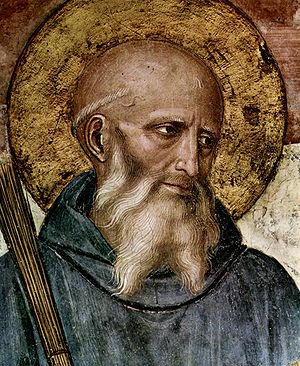Portal:Catholic Church/Patron Archive/July 11 2007

Saint Benedict of Nursia (c. 480 AD – 547 AD) was an Italian saint, the founder of the Benedictine order.
Benedict founded twelve monasteries, the best known of which was his first monastery at Monte Cassino in the mountains of southern Italy. The monastery at Monte Cassino was the first Benedictine monastery (most monasteries of the Middle Ages were of the Benedictine Order). Benedict wrote a set of rules governing his monks, the Rule of Saint Benedict, which was heavily influenced by the writings of John Cassian. The Benedictine Rule, one of the more influential documents in Western Civilization, was adopted by most monasteries founded throughout the Middle Ages. Because of this, Benedict is often called "the founder of western Christian monasticism." Benedict was canonized a saint in 1220.
The only ancient account of Benedict is found in the second volume of St Gregory's four-book Dialogues, written in 593. Book Two consists of a prologue and thirty-eight succinct chapters. 19th-century Roman historian Thomas Hodgkin praised Gregory’s life of St. Benedict as “the biography of the greatest monk, written by the greatest Pope, himself also a monk.”
Attributes:bell; broken cup; broken cup and serpent representing poison; broken utensil; bush; crosier; man in a Benedictine cowl holding Benedict's rule or a rod of discipline; raven
Patronage:against poison; against witchcraft; agricultural workers; cavers; civil engineers; coppersmiths; dying people; erysipelas; Europe; farmers; fever; gall stones; Heerdt, Germany; inflammatory diseases; Italian architects; kidney disease; monks; nettle rash; Norcia, Italy; people in religious orders; schoolchildren; servants who have broken their master's belongings; speliologists; spelunkers; temptations
Prayer:
